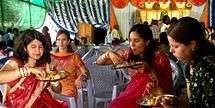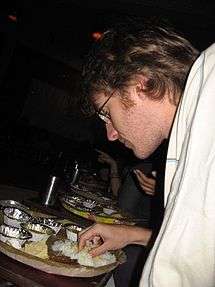Etiquette of Indian dining
 |
| This article is part of the series |
| Indian cuisine |
|---|
|
Regional cuisines
|
|
Ingredients, types of food |
|
See also
|
|
The etiquette of Indian dining varies with the region in India. Typically, both in urban and rural settings, Indians wash their hands thoroughly prior to dining, then eat with their hands, without any cutlery.[1][2] This practice is historic and premised on the cultural premise that eating is a sensual activity, and touch is part of the experience along with the taste, aroma of the food, and its presentation such as on a Thali, or on a large plate made from washed banana leaf, or stitched and washed leaves.[1] Traditionally, the fingers are also used to feel the temperature of the food to one's taste, and combine flavors such as by tearing a small portion of bread (Roti, Naan) folding it into a small pocket to scoop a desired amount of food.[3] In rural settings, sitting down together on floor mats in comfortable clothes is common. In urban homes, restaurants and hotel settings, tables and chairs are typical, while asking for cutlery and eating entirely or partially with cutlery is very common. The use of knife as cutlery is less common, since most food is prepared to be of bite size.[4][5][6]




Typically, when eating with the help of one's fingers, only one hand is used for eating, the other remains dry and only used to pass dishes or to serve or drink water.[1][6] Strict vegetarian and non-vegetarian people eat together, but the etiquette is not to mix serving utensils between the foods, to respect the spiritual beliefs of non-violence to animals prevalent among the strict vegetarians. Similarly, cleanliness and hygiene is important, and except in the cases of intimacy of a couple or a family, people usually do not dip, serve or accept food with the fingers or cutlery that have gone in someone's mouth. The food which has been dipped with fingers and cutlery used for eating is considered dushita (literally "blemished, spoiled",[7] sometimes jhoota or contaminated). The precept of not contaminating all the food or a drink with bacteria or viruses in one's saliva is of particular concern among older people and when the health of someone could be threatened through cross contamination.[6]
Most food, except bread and dessert, is served in the same plate as small servings with or without little cups. Indian food incorporates numerous whole and powdered spices sourced from various roots, barks, seeds, leafs. The whole spices such as cloves, leaves or sticks are not eaten as part of culturally accepted dining practice, just separated and set aside by the diner usually on his or her plate.[8]
Eating is usually with family and friends, with the housewife or women on the table keeping an eye on the table, bringing and offering more food. In larger group meals or celebrations, a volunteer or attendant may not eat with the group, and dedicate himself or herself to bringing meal courses, feeding and serving the group.[5] Asking for water, salt and helping oneself to items is accepted and cheered. Special requests such as less or more heat, yoghurt and other items is usually welcomed. Sometimes the group may eat silently, but asking questions to a loved one, catching up about one's day and conversations are common.[5]
Regionally, the tradition varies from not wasting food on one's plate, to only eating what one feels like and leaving the rest. Washing one's hands after the meal and drying them with a provided towel is a norm.[5]
See also
References
- 1 2 3 Melitta Weiss Adamson; Francine Segan (2008). Entertaining from Ancient Rome to the Super Bowl: An Encyclopedia. ABC-CLIO. p. 311. ISBN 978-0-313-08689-2.
- ↑ Dawn Burton (2008). Cross-Cultural Marketing: Theory, Practice and Relevance. Routledge. p. 66. ISBN 978-1-134-06017-7.
- ↑ Christine Ingram; Jennie Shapter (1999). The cook's guide to bread. Hermes. p. 118. ISBN 978-1-84038-837-4.
- ↑ Gloria Petersen (2012). The Art of Professional Connections: Dining Strategies for Building and Sustaining Business Relationships. Wheatmark. p. 358. ISBN 978-1-60494-705-2.
- 1 2 3 4 John Hooker (2003). Working Across Cultures. Stanford University Press. pp. 239–240. ISBN 978-0-8047-4807-0.
- 1 2 3 4 Madhu Gadia (2000). New Indian Home Cooking: More Than 100 Delicious Nutritional, and Easy Low-fat Recipes!. Penguin. p. 6. ISBN 978-1-55788-343-8.
- ↑ Arthur A. MacDonell (1893). A Sanskrit-English Dictionary. p. 123.
- ↑ Nina Kaul (2013). Indian Cooking Traditions. Xlibris. pp. 50, 60. ISBN 978-1-4771-8126-3.